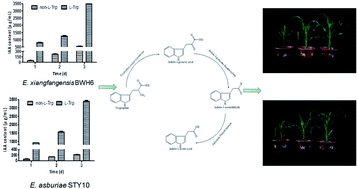Characterization and synthesis of indole-3-acetic acid in plant growth promoting Enterobacter sp.†
Abstract
Indole-3-acetic acid (IAA) plays an important role in the growth and development of plants. In this study, a series of predominant strains were isolated and identified as Enterobacter sp. with remarkable IAA-producing capabilities. The IAA-producing strains are mainly tryptophan-dependent and have significantly high yields of IAA (3477 μg mL−1 and 3378 μg mL−1). The ipdC gene encoding indole-3-pyruvate decarboxylase was identified by genomic analysis and RT-qPCR analysis, indicating the involvement of the indole-3-pyruvic acid (IPyA) pathway of IAA biosynthesis. The IPyA pathway was also confirmed by the intermediate assay. The IAA product of microbial metabolites was isolated, purified and characterized. These microbes exhibiting IAA production significantly promoted the growth of maize, increasing root length, plant height, fresh weight and dry weight. Thus, Enterobacter sp. with high IAA production has great prospects in agricultural and industrial applications.



 Please wait while we load your content...
Please wait while we load your content...